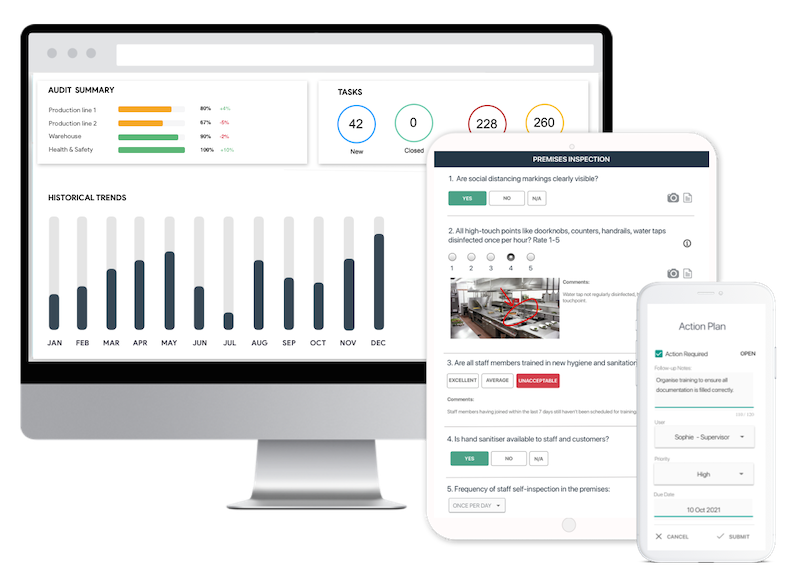- Library ›
- Food & Hospitality ›
- SALSA Beer Audit Checklist
SALSA Beer Audit Checklist
Training And Supervision
Personal Hygiene
Cleaning
Allergen Management
Process, Environment & Equipment Control
2. Are documented environmental controls monitored to ensure facilities are adequate to maintain raw materials, work-in-progress, finished products, and packaging within a safe temperature range and, where applicable, under controlled humidity, atmospheric, or other environmental parameters?
|
Photo
Comment
|
Control Of Suppliers & Raw Materials
Stock Control
Waste Control
Pest Control
Equipment
Maintenance
Vehicle Management, Storage & Distribution Control
HACCP System
2. Are product descriptions written for each product or product category, including all relevant safety factors and information? Does business management demonstrate awareness of food standards, legal regulations, and industry codes of practice applying to the products they produce, trade, handle, store, and/or distribute?
|
Photo
Comment
|
Food Safety Systems Review
Non-Conformance Investigation & Corrective Action
Traceability
Managing Incidents
Document Control
Manufacturing & Finished Product Specifications
Labeling Control
Product Shelf-Life & Product Testing
Premises Approval
External Areas & Product Security
3. Is there a food security/defense plan in place describing product security threats and how they are controlled, including measures to ensure only authorized personnel have access to production and storage areas on site? Are digital records protected in case of digital failure and digital cyber security attacks?
|
Photo
Comment
|
Site Layout & Methods Of Working
Structure, Services & Fabrication
Legal And Quality Requirements
BFBI Requirements
3. Do brewers and distillers carry out an annual program of internal audits to ensure compliance with the company's own formal procedures and the current BFBi standard, and are areas of non-compliance corrected and documented? Is the BFBI audit and self-assessment checklist completed annually, and are copies of the completed checklist and supporting documentation sent to BFBI unless a BFBI site visit is carried out?
|
Photo
Comment
|
6. If breweries use pre-milled malt, do they have confirmation from their malt supplier that they have suitable controls (e.g., magnets and/or sieves) to remove extraneous objects? Do breweries milling malt on-site ensure they have confirmation from their malt supplier that they have suitable controls (e.g., magnets and/or sieves) to remove extraneous objects, and do they subject the brewery mill to regular checks?
|
Photo
Comment
|
11. Will all members' feed materials be subject to regular random testing, undertaken by BFBi, based on risk assessment and in accordance with the FEMAS calculator requirements? Is the frequency and scope of analysis based on risk assessment taking into account potential microbiological and chemical contaminants and statutory requirements e.g. mycotoxins, dioxins, heavy metals and pesticide residues?
|
Photo
Comment
|
14. Is the testing methodology robust enough to ensure both the safety of the raw materials used and the feed ingredients supplied? Does the nature and frequency of tests carried out show consideration of the volume and potential risks associated with the raw materials and feed ingredients concerned?
|
Photo
Comment
|
16. Do participants, as a minimum, carry out tests for undesirable substances according to the frequencies indicated by the FEMAS Calculator for each of the feed materials they supply? Should participants seeking derogation from the minimum analysis frequency contact the authorized certification body?
|
Photo
Comment
|
21. Are the effectiveness of testing laboratories regularly reviewed and approved by one of the following means? i) Accreditation by a nationally recognized accreditation authority according to EN-ISO17025 for the test under consideration. ii) Validation by participating in relevant ring tests. iii) Validation by other recognized means or comparison with results of a recognized laboratory with verified quality control procedures.
|
Photo
Comment
|
Is this sample what you are looking for?
Sign up to use & customise this template, or create your own custom checklist:
Checklist by GoAudits.com – Please note that this checklist is intended as an example. We do not guarantee compliance with the laws applicable to your territory or industry. You should seek professional advice to determine how this checklist should be adapted to your workplace or jurisdiction.
Easy inspection app for your digital checklists
- Conduct inspections anytime, anywhere - even offline
- Capture photos as proof of compliance or areas needing attention
- Instantly generate and share detailed reports after the inspections
- Assign & track follow-up tasks, view historical trends on a centralized dashboard

